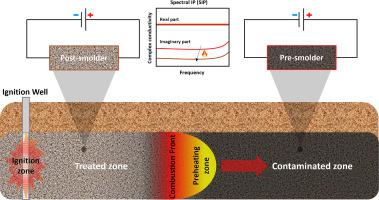Journal of Contaminant Hydrology ( IF 3.6 ) Pub Date : 2023-11-07 , DOI: 10.1016/j.jconhyd.2023.104266 Angelos Almpanis 1 , Lee Slater 2 , Jason I Gerhard 1 , Christopher Power 1

|
Monitoring the remediation of soil and groundwater contaminated by organic compounds remains highly challenging. Thermal treatments, such as smoldering combustion, have become established remediation techniques for destroying contaminants. Smoldering combustion can now be supported by colloidal activated carbon (CAC), with CAC being able to both adsorb contaminants and supplement the fuel source for destroying them. Despite this potential, effective performance monitoring of smoldering remediation remains limited. The objective of this study is to investigate the potential of the spectral induced polarization (SIP) geoelectrical technique to assess the performance of smoldering remediation of soils supplemented with CAC. SIP column experiments were first conducted to assess the response of SIP (i.e., real and imaginary components of the complex electrical conductivity) to varying concentrations of CAC in imitated field soils that contain, or do not contain, organic matter (OM). Results demonstrate that increasing OM and CAC contents increase both the real and imaginary conductivities, with the imaginary conductivity also showing frequency dependence. Smoldering and SIP column experiments were then conducted to assess the effectiveness of SIP for detecting changes in soils of varying OM and CAC contents that have been remediated by smoldering. Examination of the soils before and after smoldering indicates that SIP can track the evolving real conductivity and imaginary conductivity (in particular) between different soil compositions and different stages of the remedial process. High resolution scanning electron microscopy imaging was performed on all samples to validate the SIP and smoldering experiments, confirming significant reductions in carbon after smoldering. Overall, this study suggests that SIP has potential to track changes associated with the addition of remedial fluids like CAC in the subsurface, and the destruction of contaminants adsorbed to CAC by smoldering combustion.
中文翻译:

胶体活性炭增强阴燃修复的光谱诱导偏振特征:实验研究
监测受有机化合物污染的土壤和地下水的修复仍然极具挑战性。阴燃燃烧等热处理已成为消除污染物的成熟修复技术。现在可以通过胶体活性炭 (CAC) 支持阴燃燃烧,CAC 既能够吸附污染物,又能够补充摧毁污染物的燃料来源。尽管有这种潜力,但对阴燃修复的有效绩效监控仍然有限。本研究的目的是调查光谱激发极化 (SIP) 地电技术评估补充 CAC 的土壤阴燃修复性能的潜力。首先进行 SIP 柱实验,以评估 SIP(即复电导率的实部和虚部)对含有或不含有机物 (OM) 的模拟田间土壤中不同浓度的 CAC 的响应。结果表明,增加 OM 和 CAC 含量会增加实部和虚部电导率,其中虚部电导率也表现出频率依赖性。然后进行阴燃和 SIP 柱实验,以评估 SIP 检测阴燃修复的不同 OM 和 CAC 含量土壤变化的有效性。对阴燃前后土壤的检查表明,SIP 可以跟踪不同土壤成分和修复过程的不同阶段之间不断变化的真实电导率和虚电导率(特别是)。对所有样品进行高分辨率扫描电子显微镜成像,以验证 SIP 和阴燃实验,确认阴燃后碳含量显着减少。总体而言,这项研究表明,SIP 有潜力跟踪与在地下添加 CAC 等补救液相关的变化,以及阴燃燃烧对 CAC 吸附的污染物的破坏。



























 京公网安备 11010802027423号
京公网安备 11010802027423号